
That’s ironic, because the musical actually subverts the radical paradigm that Riggs has so beautifully crafted. Perhaps that kind of dramaturgical subversion is inevitable any time a Native writer’s work is adapted for mainstream commercial purposes. Also, the American musical is probably not the best vehicle for exploring the moral ambiguities and contradictions that are intrinsic to Riggs’ depiction of frontier life in what he specifically designates as “Indian Territory”—in other words, not the state of Oklahoma. Finally, Riggs is not only writing about colonization of Indian Territory, but also about colonization into heteropatriarchal values through a particular community ritual called "shivaree." The musical completely subverts the nature of that ritual and its pivotal role in Green Grow the Lilacs.
But first, let's look at the appropriation of Indian Territory:
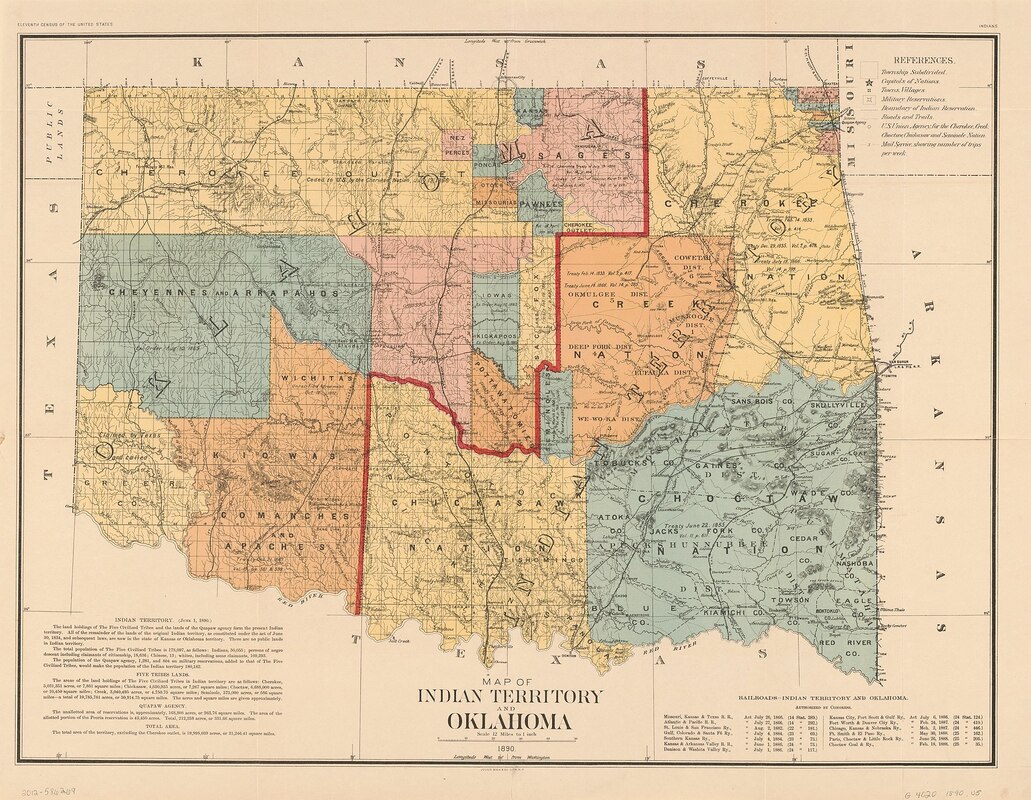
"…originally ‘all of that part of the United States west of the Mississippi, and not within the States of Missouri and Louisiana, or the Territory of Arkansas.’ Never an organized territory, it was soon restricted to the present state of Oklahoma, excepting the panhandle and Greer county. The Choctaw, Creek, Seminole, Cherokee, and Chickasaw tribes were forcibly moved to this area between 1830 and 1843, and an act of June 30, 1834, set aside the land as Indian country (later known as Indian Territory)… In 1866 the western half of Indian Territory was ceded to the United States, which opened part of it to white settlers in 1889. This portion became the Territory of Oklahoma in 1890 and eventually encompassed all the lands ceded in 1866. The two territories were united and admitted to the Union as the state of Oklahoma in 1907."
Yes, Indian Territory is on the brink of statehood in 1900, when the play opens, but Riggs makes clear this is not something about which the prairie folks are enthusiastic. Here is Aunt Eller’s speech to her neighbors from the end of the play: “Why, the way you’re sidin’ with the federal marshall, you’d think us people out here lived in the United States! It’s jist a furrin country to me. And you supportin’ it! Jist dirty ole furriners, every last one of you!”
And her neighbors are quick to respond: “My pappy and mammy was both borned in Indian Territory! Why I’m jist plumb full of Indian blood myself.” “Me, too! And I c’n prove it!”
In most productions, the characters of the play are presumed to be settlers, but Riggs tells us in the dialogue that they are, in fact, “full of Indian blood” and proud of it.
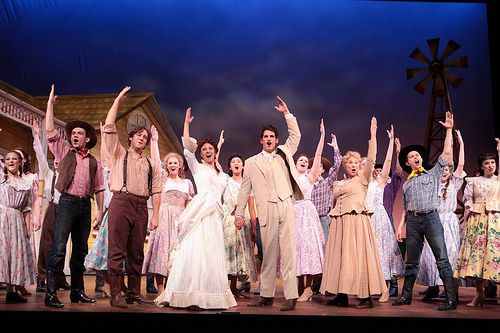 The post-shivaree scene in the musical. In Green Grow the Lilacs, it is a somber, post-traumatic reckoning.
The post-shivaree scene in the musical. In Green Grow the Lilacs, it is a somber, post-traumatic reckoning. The shivaree as depicted in Oklahoma! has become sanitized and civilized, so that it is little more than an extension of the wedding party… kind of like when the bridesmaids and groomsmen sneak off to tie old shoes onto the back of the newlyweds’ car. The musical has transferred the scene from the dead of night to broad daylight. Shivarees are traditionally done in the dark. In the musical, just after the ceremony, the bride tosses her flowers over her shoulder, and then exits to change into her traveling clothes. The groom leaves to pack, and the men announce that they plan to have a shivaree. There is a vaudevillian interlude featuring a henpecked husband, and then the men return with pots and pans, making a racket. As the bride and groom exit for their travels, the men hoist the groom amiably on their shoulders… but whatever good-natured hazing they have planned is interrupted by the arrival of Judd Fry, the villain of the piece. Wielding a knife, Judd goes to attack the groom and a fight ensues that ends in Fry’s death. The shivaree has been reduced to a noisy, fraternal, daytime bon voyage party for the newlyweds.
Th shivaree in Riggs play is something completely different. It is a terrifying artifact of rape culture, and it serves to traumatize and permanently alter both protagonists in ways that are resonant with the appropriation of Indian Territory. To understand its dramaturgical significance, it’s important to look at the origins of the custom:
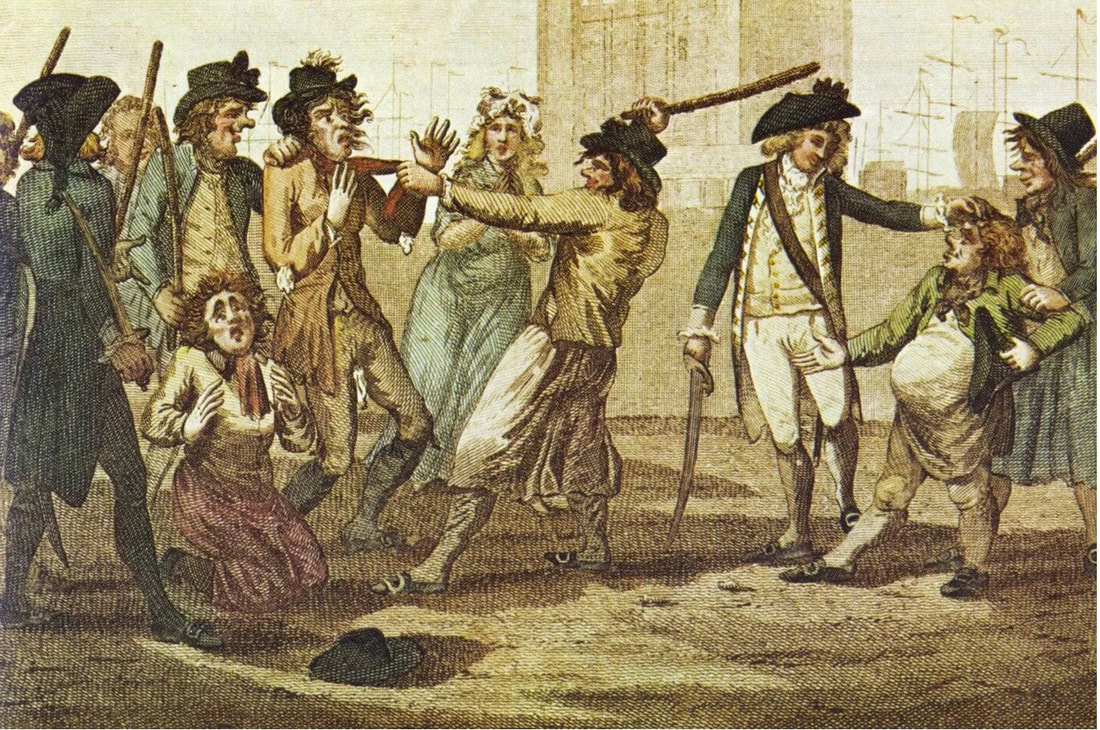
Apparently, until two hundred years ago, most Europeans thought the charivari was a legitimate and effective practice for curbing social deviance. It allowed for a public venting of outrage, with the opportunity for a “peaceful” resolution of a potentially explosive situation. In other words, it served as a kind of communal vent for blowing off steam… an exorcism of deviance. The victims were shamed, but then reintegrated into the community.
Here’s the thing: It’s actually a rape culture ritual empowering young males to assert their primacy and dominance in the community, and especially with regards to widows who dare to remarry, women who most likely were just attempting to defend themselves in abusive marriages where their husbands had legal rights to rape and batter, married women attempting to salvage some degree of bodily autonomy and/or freedom from compulsory serial pregnancy by practicing birth control or abstinence, and women who were prostituted. The historical roots of the 19th century Midwest shivaree were not in a playful hazing of newlyweds, but in a sanctioned, violent policing by gangs of young men over women who, in their eyes, were not sufficiently sexually subordinate.
Even when church and secular authorities attempted to outlaw charivari, local authorities were reluctant to prosecute these gangs of young men. Possibly, they feared reprisals against their persons or their properties, as coming between young men and what they perceive as their sexual prerogatives can be dangerous. Not surprisingly, when gang rape or other forms of violent assault occurred within the context of a charivari, the sentencing would be considerably lighter than under other circumstances.
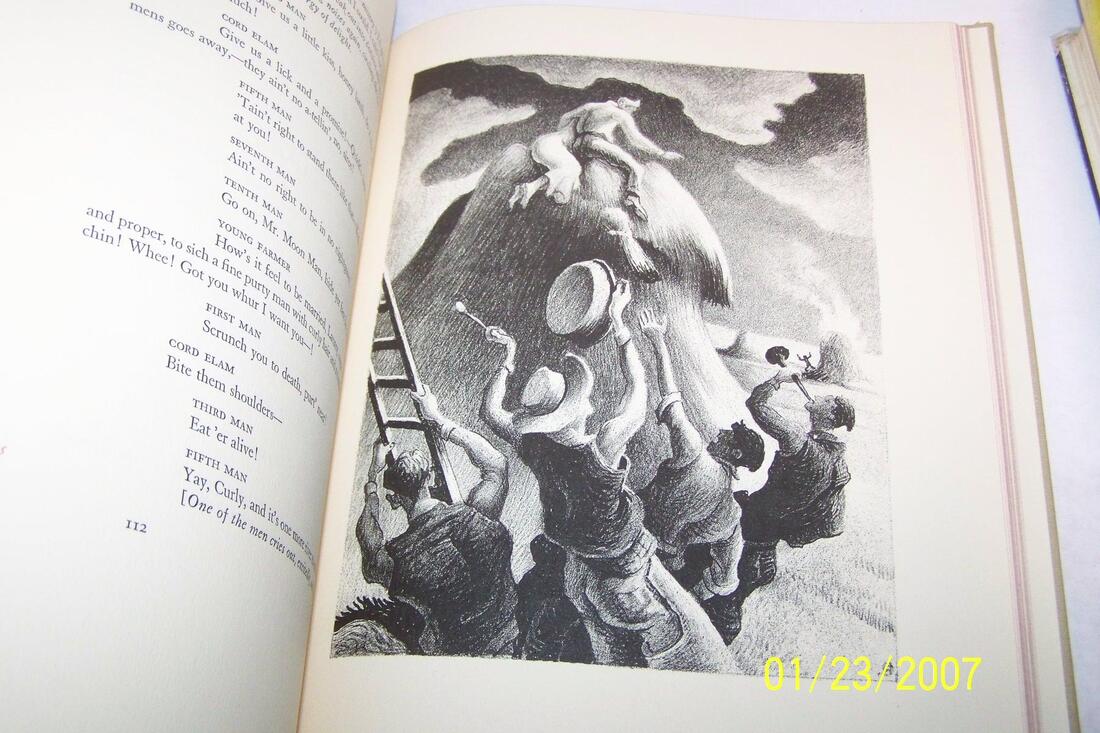 An illustration of the shivaree in Green Grow the Lilacs. You can see some of the men's comments on the facing page. In the play, the shivaree scene takes place at night.
An illustration of the shivaree in Green Grow the Lilacs. You can see some of the men's comments on the facing page. In the play, the shivaree scene takes place at night. In Green Grow the Lilacs, Riggs is writing about shivaree as practiced in 1900 in Indian Territory. It’s probable that he knew people who had experienced it. In fact, in 1900, Riggs would have been two years old, and his grandparents—if not his parents—may have been witnesses, victims, and/or participants to the kind of shivaree depicted in the play.
Unwelcome statehood looms over Indian Territory in Riggs’ play, as the final stage of a relentless and brutal colonization of the West. The shivaree looms over the protagonists of the play as a final and brutal stage of initiation into their expected gender roles in patriarchal rape culture.
Significantly, the shivaree scene opens at night. It opens as the newlyweds are attempting to sneak back into the farmhouse. Expressing the hope that nobody knows they have gotten married, they are desperate to avoid a shivaree. Laurey, the fearful bride, asks, “… if they ketch us, whut’ll happen? Will it be bad?” Her anxious groom responds, “You know about shivorees, honey. They get purdy rough.” He then assures her that they have outsmarted their would-be tormentors, but as they exit the stage, the gang of men enter in excited anticipation of capturing their prey. Their comments reflect their envy of Curly for having scored a bride who comes with “grazin and timber and plowed land,” as well as physical appeal. Their prurient excitement mounts as they note a light coming on in the bedroom, the lace curtains blowing, and the shadows passing in front of the window. As the men attempt to scale the walls of the house with a ladder, a drunken farmer appears and salaciously shouts, “No time to wait now. Time to git goin’. See that there bride a-glimmerin’ there in her white! Waitin’ fer you. Been standin’ there with her hair down her back and her lips a-movin’. Git next to her, brother! Gonna be high ole times, gonna be Jesus into yer heart!”
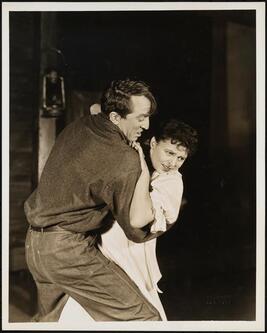 Laurey being assaulted by Jeeter in an earlier scene.
Laurey being assaulted by Jeeter in an earlier scene. The men have leaned a ladder up the side of a haystack and they force Laurey to mount it. Then they force Curly to climb up after her, amid lascivious catcalls. When both are at the top, they pull the ladder down. The men have urged the bride to “Make out it’s a bed, why don’t you!” They begin coaching the couple to kiss and for Curly to bite her shoulder and “eat her alive.” As the men’s “orgy of delight” (Riggs' description) increases in its frenzy, one of the men calls out “Ain’t no right to be in no nightgown!” Another man taunts the bride, “How’s it feel to be married, Laurey, sugar, all safe and proper, to sich a fine purty man with curly hair and a dimple on his chin! Whee! Got you whur I want you—” The men begin to toss straw babies up to the top of the haystack, counting them out as they mock the couple.
Suddenly Curly cries out that the haystack is on fire. He begs for the ladder to be replaced, but the men ignore him as Jeeter (the Judd Fry character in Oklahoma!) enters with a torch. Curly jumps down and a fight ensues. Laurey climbs down from the haystack in time to witness the death agony of Jeeter. The scene ends with Laurey in shock, repeating “He laid there in the stubble, so quiet, th’ his eyes open, and his eyeballs white and starin’! He laid there in the stubble—th’ his eyes open—!
The shivaree is not gratuitous violence. It is the pivot of the play, in which Riggs has initially depicted the community as wholesome and even puritanical, counterposed against Jeeter’s solitary indulgence in pornography. But with the shivaree scene, the black-and-white moral world of the play is turned inside out. Under cover of darkness, the upstanding citizens of the town transform themselves into rapists and terrorists. What is Riggs telling us here? And how does it fit with the context of an indigenous territory about to become annexed as a state?
In the subsequent scene, three days later, Curly is in jail awaiting a form of prairie justice that may or may not honor his plea of self-defense. Laurey, sleepless, has been hiding in her room since the shivaree. She emerges in the lamplight, “looking very pale and changed, years older, a woman now.” Her speech indicates that she is distracted and dissociated, dwelling on the events of the shivaree:
When her aunt attempts to comfort her, Laurey insists that she can never forget what she’s seen: “Over and over! The way the men done. The things they said. Oh—why’d it have to be that-away!”
Finally, Aunt Eller admits the futility of attempting to forget. This is the pivotal speech of the play: “They’s things you cain’t get rid of—lots of things. Not if you live to be a hundred. You got to learn. You got to look at all the good on one side and all the bad on the other, and say ‘Well, all right, then!’ to both of ‘em.”
And with that, and a few more speeches about how hard a woman’s life is, Laurey admits she’s been “sich a baby” and becomes, what the playwright intends us to understand as an adult woman. Here is her transformative speech:
Laurey has accepted her annexation into the role of wife and mother. She will forget what she has experienced at the hands of the town’s citizens. She will put up with everything now.
 Cherokee playwright Lynn Riggs
Cherokee playwright Lynn Riggs Riggs was a gay Cherokee playwright, born in Indian Territory in 1899. He was a disappointment to his father, a banker and a rancher. Photographs of Riggs show him to be a man of slight build, something of an “egghead” with his glasses and premature balding. What was his experience with the hypermasculinity and heteronormativity of the West? Did he experience hazing and bullying as a rite of passage? Did he learn to “stand it” in order to become an adult? Is he telling us something about the survival of his people, as each new generation has had to face a heritage of ongoing violence, denigration, and theft?
The musical adaptation has appropriated Riggs’ deeply disturbing play in order to generate a post-war celebration of America, and especially of American expansionism. (Hawaii and Alaska were still territories when the musical opened.) Male violence, which Riggs characterizes as central to the enforcement of "family values," is relegated to the perverted outsider (Jeeter), who can be easily exorcized. In fact, Oklahoma! tells a colonizer's fanciful story--personal and politcal.
Green Grow the Lilacs is an Indian play, and its significance far outweighs its role as appropriated source material for Oklahoma! The play stands on its own merits and occupies a critical place in Native American drama, documenting a pivotal time in history. Riggs' treatment of the shivaree as a paradigm for colonization/annexation is still ahead of its time.

 RSS Feed
RSS Feed
